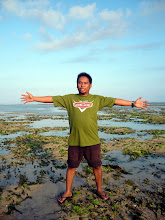Center Zone
Saturday, April 4, 2009
Sulawesi Indonesia
Monday, March 2, 2009
Papua Indonesia
Monday, February 23, 2009
Lombok & Nusa Tenggara, Indonesia

Looking for sun, sea and sand without the usual holiday crowd? Senggigi is Lombok’s most developed tourist region and many first-class resorts around the secluded bays and tranquil beaches. Tanjung Aan is probably Lombok’s finest beach. Northwest of the island are the emerald-like islands of Gili Air, Gili Meno and Gili Trawangan. Boasting powder white beaches, crystal-clear waters and an amazing underwater world, these islands are perfect for diving and snorkeling.
Sekotong and Bangko-Bangko in Lombok, and Lakey Beach in Sumbawa are the world famous Desert Point surf location. But Roti Island is where the best surfing is to be had in nusa Tenggara. Snorkeling on the coral reefs reveals fantastic coral informations and an amazing variety of fish. For such an experience, explore Moyo and Satonda Islands.
East Nusa Tenggara’s Flores is crowed with volcanoes and mountains, the most fantastic is Mount Kelimutu with its three colored crater lakes. Other natural wonders just waiting to be discovered is a red water lake at Mount Wawu Muda near Bejawa. At Lewoleba on the island of Lembata in the Solor Archipelago, follow pearl divers out to sea and watch them harvest pearls. Trek and climb Mount Rinjani (3726m), the third highest mountain in Indonesia. Its two crater lakes are popular camping sites before reaching the top.
The Komodo National Park on Komodo Island is home to the world’s only pre-historic “Dragon” or giant lizards which can measure more than 3 meters and weigh over 130 kg. At Liang Bua near Labuan Bajo, pre-historical remains provide an interesting insight into the past.
In Lombok, stop at several traditional Sasak Villages of Sade and Tansang-Angsang. At Batu Tering, a stone sarcophagus believed to be 2000 years old bears a foot imprint said to be made by the gods. The highland town of Bajawa is a good place to see the one of most traditional communities in Flores with traditional thatched and peaked huts raised on stilts as well as enormous megalithic tombs. Roti Island’s inhabitants are fond of dancing and music. One of their distinctive instruments is the “sasando”, a stringed instrument made of Palmyra leaves.
Labels:
beach,
extreme vacation,
gili trawangan,
holiday,
komodo,
komodo island,
mountain kelimutu,
roti island,
sasando,
senggigi,
surving
Subscribe to:
Posts (Atom)

